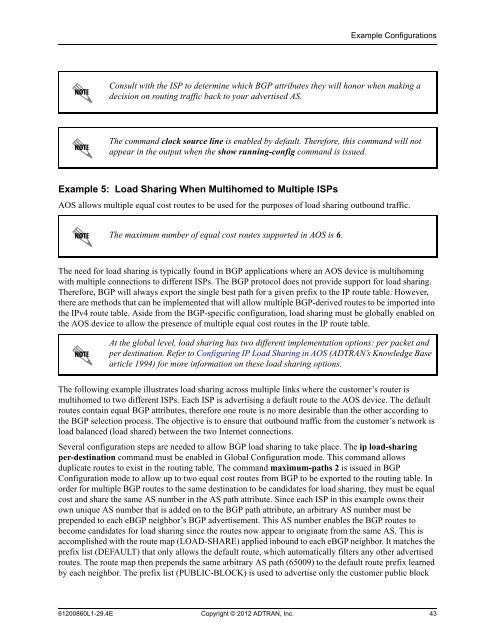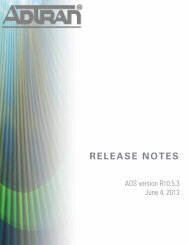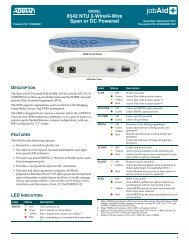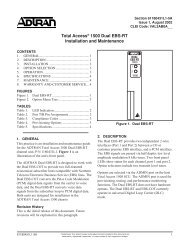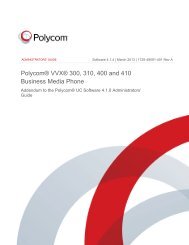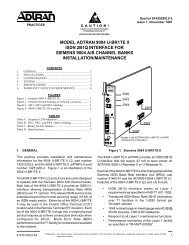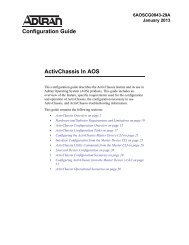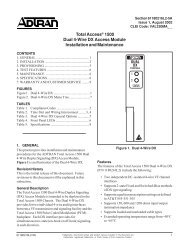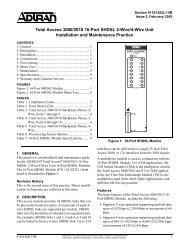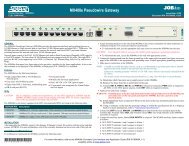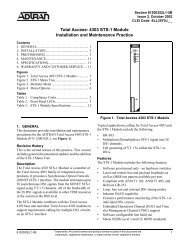View - ADTRAN Support Community
View - ADTRAN Support Community
View - ADTRAN Support Community
You also want an ePaper? Increase the reach of your titles
YUMPU automatically turns print PDFs into web optimized ePapers that Google loves.
Example Configurations<br />
Consult with the ISP to determine which BGP attributes they will honor when making a<br />
decision on routing traffic back to your advertised AS.<br />
The command clock source line is enabled by default. Therefore, this command will not<br />
appear in the output when the show running-config command is issued.<br />
Example 5: Load Sharing When Multihomed to Multiple ISPs<br />
AOS allows multiple equal cost routes to be used for the purposes of load sharing outbound traffic.<br />
The maximum number of equal cost routes supported in AOS is 6.<br />
The need for load sharing is typically found in BGP applications where an AOS device is multihoming<br />
with multiple connections to different ISPs. The BGP protocol does not provide support for load sharing.<br />
Therefore, BGP will always export the single best path for a given prefix to the IP route table. However,<br />
there are methods that can be implemented that will allow multiple BGP-derived routes to be imported into<br />
the IPv4 route table. Aside from the BGP-specific configuration, load sharing must be globally enabled on<br />
the AOS device to allow the presence of multiple equal cost routes in the IP route table.<br />
At the global level, load sharing has two different implementation options: per packet and<br />
per destination. Refer to Configuring IP Load Sharing in AOS (<strong>ADTRAN</strong>’s Knowledge Base<br />
article 1994) for more information on these load sharing options.<br />
The following example illustrates load sharing across multiple links where the customer’s router is<br />
multihomed to two different ISPs. Each ISP is advertising a default route to the AOS device. The default<br />
routes contain equal BGP attributes, therefore one route is no more desirable than the other according to<br />
the BGP selection process. The objective is to ensure that outbound traffic from the customer’s network is<br />
load balanced (load shared) between the two Internet connections.<br />
Several configuration steps are needed to allow BGP load sharing to take place. The ip load-sharing<br />
per-destination command must be enabled in Global Configuration mode. This command allows<br />
duplicate routes to exist in the routing table. The command maximum-paths 2 is issued in BGP<br />
Configuration mode to allow up to two equal cost routes from BGP to be exported to the routing table. In<br />
order for multiple BGP routes to the same destination to be candidates for load sharing, they must be equal<br />
cost and share the same AS number in the AS path attribute. Since each ISP in this example owns their<br />
own unique AS number that is added on to the BGP path attribute, an arbitrary AS number must be<br />
prepended to each eBGP neighbor’s BGP advertisement. This AS number enables the BGP routes to<br />
become candidates for load sharing since the routes now appear to originate from the same AS. This is<br />
accomplished with the route map (LOAD-SHARE) applied inbound to each eBGP neighbor. It matches the<br />
prefix list (DEFAULT) that only allows the default route, which automatically filters any other advertised<br />
routes. The route map then prepends the same arbitrary AS path (65009) to the default route prefix learned<br />
by each neighbor. The prefix list (PUBLIC-BLOCK) is used to advertise only the customer public block<br />
61200860L1-29.4E Copyright © 2012 <strong>ADTRAN</strong>, Inc. 43


